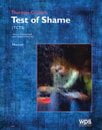
Thurston Cradock Test of Shame tcts
For: Provides an open-ended, clinically rich assessment of shame
Reading Level: Children and adults
Format: Paper-and-Pencil
Length: 20 to 30 minutes
Scoring: Hand Scored
Author
Nancy S. Thurston, Psy.D., and Julie Cradock O’Leary, Ph.D.
Description
Shame may be difficult to evaluate because it is a feeling that people tend to hide. In addition, the self-report instruments typically used to measure shame limit client responses to a given set of options. For these reasons, assessments of shame are often inaccurate or incomplete.
The new Thurston Cradock Test of Shame (TCTS) offers an alternative approach that’s less confining, more subtle, and more informative than self-report measures. The TCTS solicits open-ended responses to ambiguous stimuli. Because it does not restrict client responses, the TCTS can access internalised conflicts, needs, and fantasies, uncovering rich clinical data.
10 stimulus cards elicit meaningful responses
The TCTS uses a set of 10 stimulus cards designed to evoke stories with shame-based themes. Clients are asked to tell a story about the characters and events depicted on each card. The examiner records these stories verbatim, along with behavioural observations. The test can be administered in 20 to 30 minutes, following detailed, card-by-card instructions provided in the Manual.
Six of the TCTS cards pull explicitly for shame themes, while four are more ambiguous. Eight are illustrated in black and white, and two (one shame-themed and one ambiguous) include colour. Nine cards depict children and adolescents, while eight show adults. Research and clinical experience with the cards indicate that both children and adults can connect with all characters shown, young or old. Therefore, the TCTS can be used with individuals of virtually any age.
Detailed case examples simplify evaluation
The TCTS Summary Form may be completed in just 10 to 20 minutes. It provides a convenient framework for analysing client stories, which are evaluated with the following considerations in mind:
Is shame indicated in the story?
What kind of shame defences are most prevalent?
Is the story resolved in an adaptive or maladaptive way – or is it unresolved?
To clarify evaluation procedures, the Manual presents eight helpful case studies. Each includes the subject’s TCTS responses, a completed Summary Form, and an interpretive commentary. The examples are from children, adolescents and adults – some with clinical syndromes (Anxiety Disorder, Asperger’s Syndrome, Conduct Disorder, and Major Depression), and some without. All case studies show how to detect shame (direct or indirect) and how to identify shame defences such as deflation, aggression, and inflation/contempt. They also illustrate adaptive and maladaptive story resolution.
Use the TCTS to help clients develop more adaptive reactions to shame
People often react to shame by withdrawing, becoming aggressive, or devaluing others. That is why it is important for clinicians to address shame – to help their clients uncover feelings of shame and find adaptive ways to respond. The TCTS is an important step in this process. It provides access to the client’s internal life and a path toward resolving shameful feelings. It is useful in assessing victims of domestic violence, sex offenders, bullies and their targets, as well as clients with depression, anger problems, eating disorders, or relationship problems. In addition, TCTS stories provide relevant material for follow-up in cognitive-behavioural therapy interventions.
NB: Prices are in Australian dollars inclusive of GST. NZ customers need to log in to view ex-GST prices.



